The rich lushness of the Crocosmia flowering in late summer, is a sign that autumn is imminent. The increasingly golden light of autumn perfectly enhances the oranges and reds of this season of change, preceding the more subtle colours of winter.
Also known as Falling Stars, the name Crocosmia literally means “smells like saffron”, as dried flowers, when soaked in warm water are reputed to give off a saffron-like scent. Crocosmia are not related to the domesticated crocus (Crocus sativus), thought to have originated in the Mediterranean region, which produces the saffron spice that is derived from the stamens of the flowers.
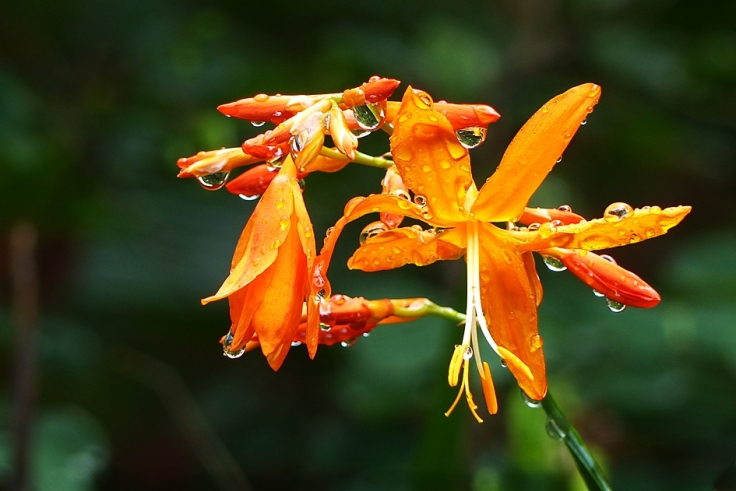
Crocosmia belong to the Iridaceae (iris) family
There are nine southern African Crocosmia, with seven occurring in South Africa. Occurring in the eastern part of the country in damper habitats such as forest edges and the banks of streams (and in our garden) is Crocosmia aurea. The second part of the name comes from the Latin word aurea, which means golden. (The name oriole, for the birds that are most often bright yellow/gold in colour, also derives from aurea.)

It’s easy to see why the flowers are referred to as falling stars. The cheering flowers can brighten up damp corners in the garden and Crocosmia mixes in well with other plants
Like most members of the iris family, Crocosmia have long sword-like leaves, and they die down completely becoming dormant in winter, resurrecting in the spring.
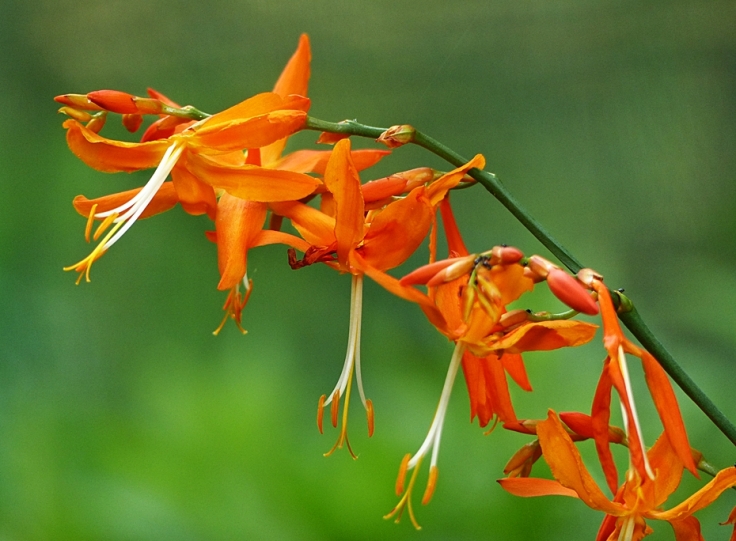
The flowering season of Crocosmia aurea lasts from late summer through to early winter. The graceful flower stems are popular as cut flowers in a vase

Hardy under the right conditions, Crocosmia aurea spread as the corms multiply along runners. In the wild, the corms are eaten by bush pigs. Crocosmia self-seed readily. The purple seeds, housed in orange capsules that eventually split open, are eaten by birds
In our garden, we leave the plants to form small colonies, but as they tend to spread, they get weeded out where they are not wanted, such as in the vegetable patch, although there are a few stray plants there brightening up the lettuces at this time of the year. Crocosmia hybrids are popular all over the world, and there are numerous cultivars available from nurseries. Unfortunately, these hybrids can become invasive, outcompeting indigenous species. Robust hybrids have become a problem in several African countries, in the United Kingdom, New Zealand, Australia and elsewhere.
The plant known as Montbretia is a hybrid of Crocosmia aurea and Crocosmia pottsii. This hybrid was developed in France as an ornamental and is so intrusive that it is categorised as a Noxious Weed in New South Wales in Australia, where it may not be sold or propagated. Once established, these plants are difficult to eradicate.

Flower buds of a Crocosmia aurea in our garden
If there is a moral to the story, beware of hybrid ornamentals, especially if they are known to be invasive. Choose indigenous plants for gardens and even as pot plants when you can. It is fascinating to discover the origin of plants, and learn that a surprising number of plants that have become part of our culture originally came from faraway places. And it is equally interesting and rewarding to rediscover neglected plants that are in fact indigenous, easy to grow but non-invasive, and beautiful, each in their own way, and they provide food and shelter for a variety of insects, birds and other animals.
Sources: Elsa Pooley. 1998. A Field Guide to Wild Flowers of KwaZulu-Natal and the Eastern Region. Durban: Natal Flora Publications Trust; NSW Weed Wise http://weeds.dpi.nsw.gov.au/Weeds/Details/88#declarations; PlantZAfrica https://www.plantzafrica.com/plantcd/croscosaurea.htm

Posted by Carol



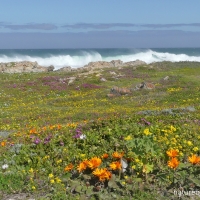
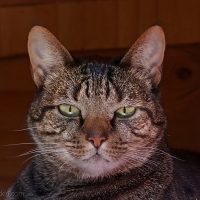
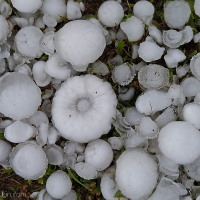
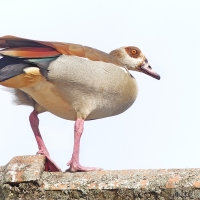


March 3, 2017 at 5:31 am
Lovely pictures and beautiful writing as always! Like you, I go for indigenous as far as possible. These flowers take me right back to the farm I grew up on in the now Mpumalanga, where the crocosmia lined one section of the large vegetable garden my mother had developed. Although she called them Montbretia, they were as local and indigenous as one can get – another lot grew in the veld near our farm dam.
LikeLiked by 1 person
March 3, 2017 at 6:13 am
Thanks Anne. Thanks for sharing lovely memories. Indigenous plants so often bring with them rich associations with times past and with wild places. So much more interesting than manicured and over domesticated plants I think!
LikeLiked by 1 person
March 2, 2017 at 10:44 pm
I have this growing in my own garden, and it is one of my favourite summer flowering plants. Wonderful photos!
LikeLiked by 1 person
March 3, 2017 at 6:07 am
Thanks Pete. It is a lovely flower. Nice to know that you enjoy it too.
LikeLiked by 1 person
March 2, 2017 at 9:11 pm
Ah! Your crocosmia come to maturity as ours tentatively push their first young shoots above the earth. In our climate, they’re rarely invasive, and spread relatively slowly.
LikeLiked by 1 person
March 3, 2017 at 6:05 am
Our autumn is nicely balanced with your spring! Good that your climate controls the crocosmia’s takeover tendencies.
LikeLiked by 1 person